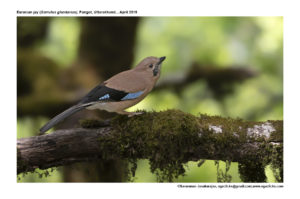Eurasian Jay

Eurasian Jay Garrulus glandarius
Etymology:
- Garrulus : Latin word for babbling, chattering derived from garrire – to chatter.
- Glandarius : Latin word for of acorns derived from glandis- acorn.
Vernacular Names : Lepcha: Lho khario pho, Cachar: Dao flampu
Distribution in India: Resident of Himalayas and North East India.
Description: Size of 32-36 cm. It is a broad-winged woodland bird with hesitant, shallow-flapping wing action; small to medium-sized bill, nostrils just concealed by soft nasal tuft, slightly elongated crown feathers which can be elevated into short, ruffled crest, medium-length tail with squared tip; plumage pinkish-grey or reddish-brown with wholly black tail and contrasting white rump. The nominate race has forehead and crown, lores and area around eye whitish, crown streaked black, nasal tuft whitish or buff. The chin and throat are whitish, bold black malar stripe; rear crown, sides of head and most of body plumage light to medium pinkish brown to reddish brown, vent and both uppertail-coverts and undertail-coverts white; tail black, becoming greyer towards base; upperwing pattern complex, but essentially lesser and median coverts rufous, primary-coverts and outer greater coverts bright blue with fine black barring, inner greater coverts black, primaries greyish black with narrow whitish edges on outer webs, secondaries blackish with white bases on outermost five feathers, innermost tertial chestnut with black tip; iris bluish white; bill brownish horn; legs flesh-brown. Both the sexes are similar.
Habitat: It is found in woodlands and forests of all kinds, parks, orchards and large gardens. It is found between lowland and 4000 m.
Food Habits: It is omnivorous. It eats invertebrates during breeding season, also small lizards and the eggs and nestlings of small birds; diet includes variety of seeds and berries, especially in autumn and winter, including pine seeds. Scavenges discarded household food scraps around villages. An interesting behavior observed in this bird is that it is a gatherer of acorns. Throughout autumn and into winter builds up caches of acorns, burying them individually in leaf litter on forest floor or beneath clumps of brambles or ferns, and has been estimated that a single jay could store 3000 acorns in one month, making this species one of the most prolific planters of oaks; by following summer many acorns will have germinated, and the jay has learnt that a germinating seedling is attached to an acorn and will select these while foraging in summer. It is extremely shy and wary, keeping very much to cover of dense foliage. It utilizes lowest airspace, flying between trees with hesitant action; during sporadic eruptive movements. It forages in more open situations than either of those, and often found alongside mixed-species groups, such as Laughingthrushes, as they roam through shrubby gulleys.
Breeding Habits: Breeds in March-Feb in India. The nest is built by both sexes. The nest is a well-constructed, a platform of twigs around a relatively deep cup, lined with soft plant materials, above ground and often at junction of substantial branch and main trunk, rarely in tree cavity, well concealed by foliage, typically near tree center or lower crown. It lays a clutch of 3–10 eggs. The incubation is done by female only, fed on nest by male for a period 16 -19 days. The nestling period is 19-23 days. The young become independent of parents after 7–8 weeks, when parents can become aggressive towards them.